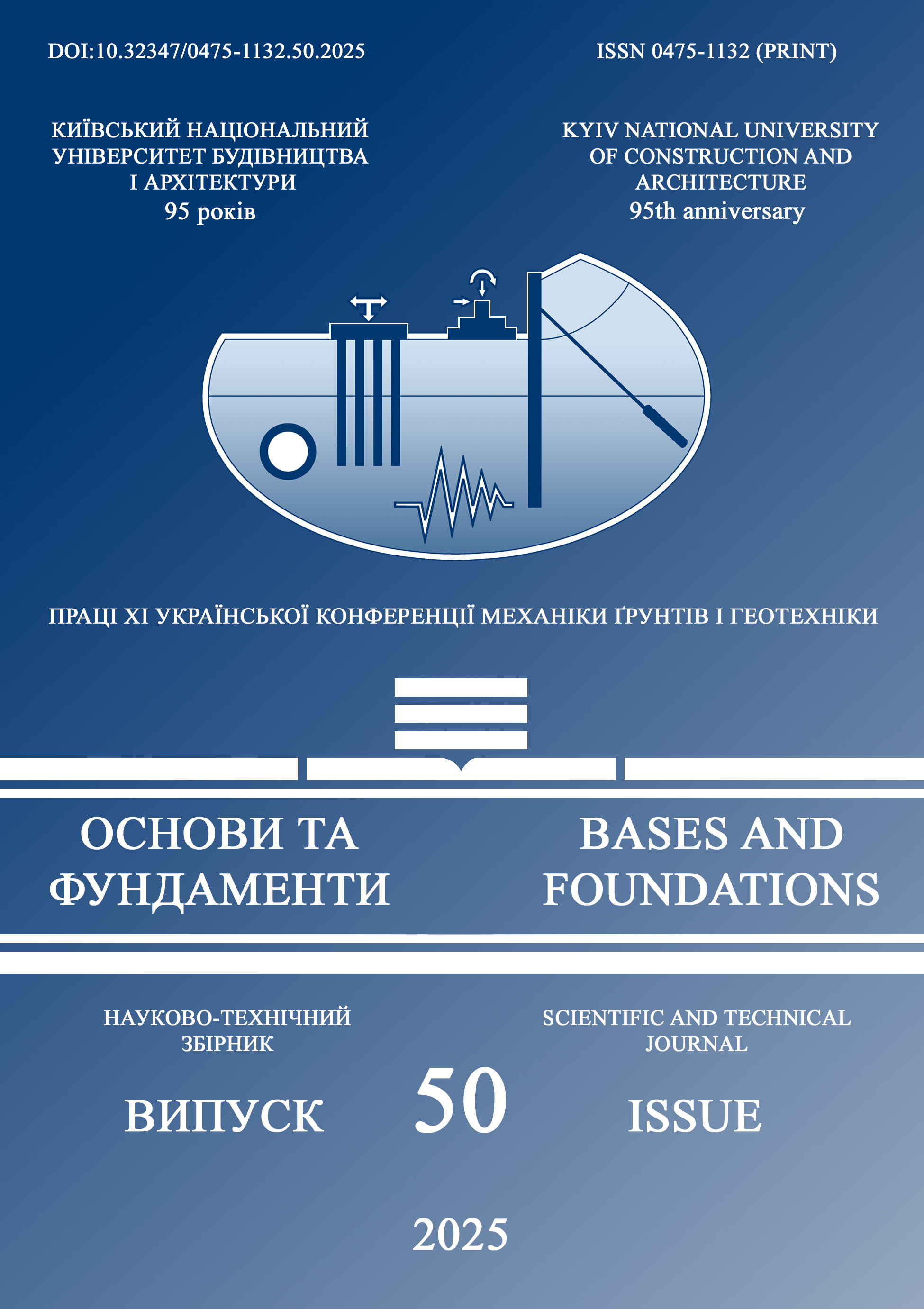Оцінка переміщень підпірних стін та оточуючих будинків при влаштуванні глибокого котловану в умовах щільної міської забудови
Основний зміст сторінки статті
Анотація
Приведено порівняння результатів геодезичного моніторингу переміщень існуючих будівель і конструкцій підпірних стін та числового моделювання напружено-деформованого стану (НДС) системи «ґрунт - підпірні стіни - існуючі будівлі» при влаштуванні котловану в умовах щільної міської забудови.
Числове моделювання НДС системи «ґрунт - підпірні стіни - існуючі будівлі» виконано у тривимірній постановці, що дає можливість коректно оцінити НДС системи за рахунок врахування просторової жорсткості конструкцій.
Показано, що безпосереднє використання параметрів ґрунтів, наведених у звіті про інженерно-геологічні вишукування, для числового моделювання НДС системи «ґрунт - підпірні стінки - існуючі будівлі» без їх ідентифікації може призвести до значної у 2-3,5 рази похибки у визначенні розрахункових значень переміщень конструкцій і ґрунтів. Відповідно виникає необхідність у ідентифікації параметрів ґрунтів.
Ідентифікація параметрів ґрунтів дає змогу отримати хорошу збіжність даних числового моделювання та фактичних даних моніторингу.
Виконано зворотний аналіз та ідентифікацію параметрів моделі ґрунту для збіжності результатів числового моделювання та натурних спостережень. Рекомендовано уточнювати параметри моделі ґрунту на основі лабораторних досліджень параметрів ґрунту в широкому діапазоні навантажень/розвантажень з використанням одновісного та тривісного стиснення ґрунту.
Альтернативним методом ідентифікації розрахункових параметрів моделі ґрунту є виконання дослідних котлованів для визначення фактичних значень переміщень підпірних стін та на основі зворотного аналізу уточнення розрахункових параметрів моделі ґрунту для узгодження результатів числового моделювання та даних фактичних вимірювань переміщень конструкцій. Впровадження цих рекомендацій дозволяє наблизити прогнозовані за допомогою числового моделювання значення переміщень конструкцій до реальних значень при виконанні будівельних робіт.
Блок інформації про статтю

Ця робота ліцензується відповідно до Creative Commons Attribution 4.0 International License.
Автори, які публікуються у цьому журналі, погоджуються з наступними умовами: Автори залишають за собою право на авторство своєї роботи та передають журналу право першої публікації цієї роботи на умовах ліцензії Creative Commons Attribution License, котра дозволяє іншим особам вільно розповсюджувати опубліковану роботу з обов'язковим посиланням на авторів оригінальної роботи та першу публікацію роботи у цьому журналі. Автори мають право укладати самостійні додаткові угоди щодо неексклюзивного розповсюдження роботи у тому вигляді, в якому вона була опублікована цим журналом (наприклад, розміщувати роботу в електронному сховищі установи або публікувати у складі монографії), за умови збереження посилання на першу публікацію роботи у цьому журналі. Політика журналу дозволяє і заохочує розміщення авторами в мережі Інтернет (наприклад, у сховищах установ або на особистих веб-сайтах) рукопису роботи, як до подання цього рукопису до редакції, так і під час його редакційного опрацювання, оскільки це сприяє виникненню продуктивної наукової дискусії та позитивно позначається на оперативності та динаміці цитування опублікованої роботи (див. The Effect of Open Access).Посилання
Bozkurt, S., Abed, A., & Karstunen, M. (2023). 2D & 3D numerical analyses of a deep excavation supported by LC columns (L. Zdravkovic, S. Kontoe, A. Tsiampousi, & D. Taborda, Eds.). In: 10th European Conference on Numerical Methods in Geotechnical Engineering (pp. 1-6). London: Imperial College London. https://doi.org/10.53243/NUMGE2023-188
Di Mariano, A., Arroyo, M., Gens, A., Amoroso, S., & Monaco, P. (2021). SDMT testing and its use in the numerical simulation of a deep excavation (T. Huszák, A. Mahler & E. Koch, Eds.). In: 6th International Conference on Geotechnical and Geophysical Site Characterization. Budapest: was held online. https://doi.org/10.53243/ISC2020-204
Dodigovic, F., Agnezovic, K., Ivandic, K., & Strelec S. (2022). An example of the protection of a deep excavation in an urban environment. Environmental Engineering, 9(1-2), 83-94. https://doi.org/10.37023/ee.9.1-2.9
Mitew-Czajewska, M. (2019). A study of displacements of structures in the vicinity of deep excavation. Archives of Civil and Mechanical Engineering, 19(2), 547-553. https://doi.org/10.1016/j.acme.2018.11.010
Носенко, В.С., Маламан, А.Р., & Сорока, П. (2024). Моніторинг за деформаціями огородження глибокого котловану та оточуючих будинків в умовах щільної міської забудови. Основи та фундаменти: Науково-технічний збірник, 49, 23-32.
DOI: 10.32347/0475-1132.49.2024.23-32
Bentley Systems. (2022). PLAXIS Material Models Manual: CONNECT Edition V22.01.
Schanz, T., Vermeer, P.A., & Bonnier P.G. (1999). The Hardening Soil Model: Formulation and Verification. Beyond 2000 in Computational Geotechnics – 10 years of Plaxis, 1, 281-296.
Yan, X., Tong, L., Li, H., Liu, W., Xiao, Yu., & Wang W. (2025). Effects of the excavation of deep foundation pits on an adjacent double-curved arch bridge. Underground Space, 21, 164-177. https://doi.org/10.1016/j.undsp.2024.09.001
Яковенко, М. (2021). Просторова модель та розвиток деформацій в часі за результатами геодезичного моніторингу підпірної стіни. InterConf, 51, 962-972.
https://ojs.ukrlogos.in.ua/index.php/interconf/article/view/11725
Bozkurt, S., Abed, A., & Karstunen, M. (2023). 2D & 3D numerical analyses of a deep excavation supported by LC columns (L. Zdravkovic, S. Kontoe, A. Tsiampousi, & D. Taborda, Eds.). In: 10th European Conference on Numerical Methods in Geotechnical Engineering (pp. 1-6). London: Imperial College London. https://doi.org/10.53243/NUMGE2023-188
Di Mariano, A., Arroyo, M., Gens, A., Amoroso, S., & Monaco, P. (2021). SDMT testing and its use in the numerical simulation of a deep excavation (T. Huszák, A. Mahler & E. Koch, Eds.). In: 6th International Conference on Geotechnical and Geophysical Site Characterization. Budapest: was held online. https://doi.org/10.53243/ISC2020-204
Dodigovic, F., Agnezovic, K., Ivandic, K., & Strelec S. (2022). An example of the protection of a deep excavation in an urban environment. Environmental Engineering, 9(1-2), 83-94. https://doi.org/10.37023/ee.9.1-2.9
Mitew-Czajewska, M. (2019). A study of displacements of structures in the vicinity of deep excavation. Archives of Civil and Mechanical Engineering, 19(2), 547-553. https://doi.org/10.1016/j.acme.2018.11.010
Nosenko, V.S., Malaman, A.R., & Soroka P. (2024). Monitorynh za deformatsiiamy ohorodzhennia hlybokoho kotlovanu ta otochuiuchykh budynkiv v umovakh shchilnoi miskoi zabudovy [Monitoring of deformations of the deep pit wall and surrounding buildings in dense urban areas]. Osnovy ta fundamenty: Naukovo-tekhnichnyi zbirnyk, 49, 23-32 (in Ukrainian).
DOI: 10.32347/0475-1132.49.2024.23-32
Bentley Systems. (2022). PLAXIS Material Models Manual: CONNECT Edition V22.01.
Schanz, T., Vermeer, P.A., & Bonnier P.G. (1999). The Hardening Soil Model: Formulation and Verification. Beyond 2000 in Computational Geotechnics – 10 years of Plaxis, 1, 281-296.
Yan, X., Tong, L., Li, H., Liu, W., Xiao, Yu., & Wang W. (2025). Effects of the excavation of deep foundation pits on an adjacent double-curved arch bridge. Underground Space, 21, 164-177. https://doi.org/10.1016/j.undsp.2024.09.001
Yakovenko, M. (2021). Prostorova model ta rozvytok deformatsii v chasi za rezultatamy heodezychnoho monitorynhu pidpirnoi stiny [Spatial model and development of deformations in time based on the results of geodetic monitoring of a retaining wall]. InterConf, 51, 962-972 (in Ukrainian).
https://ojs.ukrlogos.in.ua/index.php/interconf/article/view/11725
